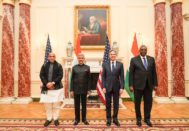Authors
Rob York

Rob York is Program Director for Regional Affairs at the Pacific Forum. He is a Ph.D. candidate in Korean history at the University of Hawaii at Manoa, where he also received his master’s degree in Asian studies. Before joining the Pacific Forum, York worked as a production editor at The South China Morning Post and as chief editor of NK News, a specialist site focused on news and analysis of North Korea. York’s research specialties include North Korean diplomacy and leadership politics, as well as East Asian trade and media discourse. He has worked for newspapers in the United States, South Korea and Hong Kong, and earned his bachelor’s degree in communications from Southern Adventist University in Tennessee.
Articles by Rob York
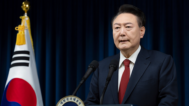
US - Korea
May — December 2024The Worst Angels of Our Nature
The last several reporting periods of Comparative Connections have featured little drama in US relations with the two Koreas. A lot of important changes happened—a burgeoning Washington-Seoul-Tokyo trilateral, Pyongyang’s advancing nuclear weapons program, etc.—but these developments were mostly incremental. However, the June-December 2024 reporting period—the final Comparative Connections—has featured bombshells, both metaphorically and literally. The most spectacular event was South Korean president Yoon Suk Yeol going full rogue authoritarian and recklessly declaring martial law at 11pm on December 3 in order to carry out a military “self-coup d’état.” That is, Yoon annulled democratic processes and civil constitutional protections, arrogated all political and executive power to himself and the military, and attempted to suspend the national assembly. This shocking step toward tyranny—considered long-relegated to the distant past of South Korea’s developmental dictatorships of the 1950s-1980s—was as badly conceived as it was executed, farcically falling apart after less than three hours, when legislators (mostly from the opposition) breached the cordon of deployed soldiers around the national assembly, entered the plenary chamber, and voted 190-0 to revoke the martial law decree.
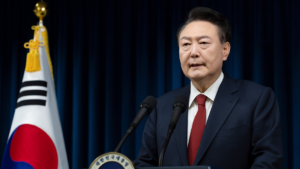
Figure 1 South Korean President Yoon Suk Yeol speaks at the presidential office in Seoul, South Korea, Saturday, Dec. 7, 2024. Photo: AP
In addition to a raft of political and security instabilities (see next section) introduced by the self-coup attempt, the “values-based” US-South Korea alliance is now shaken to the core by a wanton power-grab of an allied leader close to the US.
And it is not as though the US-South Korea alliance was steaming toward placid political waters in any event, as the re-election of another noted destroyer of domestic democratic norms—Republican Donald Trump—won re-election as US president in November, following the dramatic cognitive and physical decline of Democratic president Joe Biden, who was forced out of his re-election campaign and replaced by hapless vice-president Kamala Harris. Beyond Trump’s own capacity to undermine the democratic values that supposedly support the US-South Korea alliance, his negative proclivities toward alliances, which he views primarily transactionally, and plans for tariffs and other measures potentially unfavorable to South Korea, were already promising friction between Seoul and Washington. The likely impending replacement of Yoon (a pro-US conservative) by a (typically) US-lukewarm progressive South Korean president would make the friction greater.
Finally, North Korea has provided the literal bombshell—many bombshells, in fact—during this Comparative Connections reporting period, as the Kim Jong Un regime has supplied Russia with millions of artillery shells and (likely) hundreds of short-range ballistic missiles and multiple launch rockets to support Moscow with materiel for the prosecution of its illegal war of aggression against Ukraine. This has been augmented by North Korea’s dispatch of at least 10,000 troops to the Kursk region of Russia. This not only marks a clear escalation in Pyongyang’s support for Moscow, but also likely furthers the arms/technology transfer flowing into North Korea, which in turn complicates deterrence and warfighting by the US-South Korea combined forces. All of this is undergirded by a newly forged Russia-North Korea military alliance, another element of the “axis of upheaval” destabilizing East Asia and sharpening the external security challenges faced by the US and South Korea.
US-South Korea Relations: South Korea Goes Rogue, the US Tees Up Trump 2.0
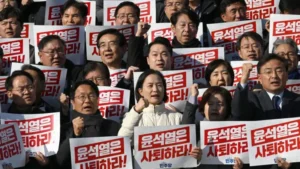
Figure 2 Lawmakers hold placards reading “Yoon Suk Yeol should resign” on 4 December. Photo: BBC News
Following months of mounting domestic political turmoil, at 10:23pm on December 3 South Korean President Yoon Suk Yeol delivered a six-minute televised address in which he cited “legislative dictatorship,” “pro-DPRK, anti-state forces,” and a raft of political subversion measures by the opposition Democratic Party as justification for an “emergency martial law” decree that went into effect at 11pm. There seems to be no policy, political, or constitutional foundation or justification for this measure, which was thus illegal, illegitimate, and authoritarian.
The thought process behind Yoon’s decision remains unclear, as does his state of mind at the time and his ostensible endgame for martial law. What is clear, however, is that Yoon—and his co-conspirators, especially the minister of national defense, Kim Yong-hyun—intended to annul democratic processes and civil constitutional protections, arrogate all political and executive power to Yoon and the military, and suspend the national assembly for an indeterminate period of time. More darkly still, Yoon and Kim apparently instructed special operations forces to arrest senior legislators and party leaders—including the conservative People Power Party head, Han Dong-hoon—and detain them at a government facility. This is especially noteworthy, given South Korea’s authoritarian history of black site torture of political dissidents.
However, the whole martial law circus collapsed within hours, as legislators managed to reach the interior of the national assembly building and convene a plenary session, during which they voted 190-0 to rescind martial law (in accord with the South Korean constitution). Although several hundred soldiers entered the national assembly building in an attempt to stop the proceedings, their efforts were clearly half-hearted, as were their efforts to prevent legislators from entering the national assembly building in the first place. Testimony from the deployed special operations commander revealed that he ordered soldiers participating in martial law enforcement not to use live rounds in their weapons, enter the plenary chamber of the national assembly, or hurt civilians. That—along with the fact that Yoon, the defense minister, and martial law commander general Park An-su did not control major media outlets—strongly suggests that the coup attempt was badly conceived and organized. It seems that Yoon had little support from and control over the military.
In any event, by 2 am on December 4 the military withdrew to its normal posts and Yoon conceded to the national assembly vote by announcing the retraction of the martial law decree, a decision that was ratified by cabinet ministers meeting in their State Council formation. Thus, by the morning of December 4 the farcical state of exception was over, with Yoon, conspiring ministers and military, and elite hard-right conservative supporters suffering a humiliating defeat. The consequences of this attempted self-coup d’état—among the most bizarre and embarrassing in modern political history—are still far from clear, but the most likely outcome is that Yoon will no longer be president. Yoon was impeached by the National Assembly on December 14, with his final removal from office now dependent on a Constitutional Court decision in 2025. The entire cabinet and suite of presidential senior officials have tendered their resignations (although many remain in post pending acceptance of their resignation), the ruling conservative People Power Party (PPP) is discredited and in shambles, and South Korea is engulfed in political chaos. Kim Yong-hyun (the now former defense minister) is under arrest for insurrection. Other cabinet ministers, senior officials, and military and police officers are likely to follow. The police and special prosecutor’s offices are now investigating Yoon himself for insurrection, conviction for which in South Korea carries penalties ranging to the death sentence.
As of the time of writing, the political situation in South Korea is chaotic and fluid. Yoon eventually indicated the inevitability of the legislative impeachment process and his will to fight post-impeachment conviction in the Constitutional Court, but at first attempted to remain in office with the support of PPP lawmakers who initially refused to support impeachment because it would (following potential conviction) lead to a snap presidential election that a candidate from the hated progressive Democratic Party would likely win. Worse still, during the first chaotic week after martial law, the PPP attempted to stay in power through a byzantine and extra-constitutional plan for Yoon to surrender his administrative power to an opaque governing committee consisting of the prime minister (Han Duk-soo) and party politicians (notably Han Dong-hoon). At best this created a power vacuum; at worst, there was for several days an unelected cabal of conservative PPP members and the prime minister engaged in a second coup d’état. Both situations represented security risk on the peninsula. For instance, it was uncertain who de facto held the top position in the South Korean chain of military command. If North Korea had attacked, it is unknown who would have been able to command the South Korean military.
Even if South Korea’s politics are restored quickly to a normal democratic state of the rule of law, Yoon’s attempted self-coup (and the apparent follow-on coup attempt by his party) will leave scars, including in terms of relations with the US. To begin with, the military dimension of the alliance was implicated in a way that casts major doubt on South Korea’s reliability as a partner. Yoon’s presidential office apparently did not inform the US in advance of the martial law decree. Chief among those uninformed was US Forces Korea and Combined Forces Command general Paul LaCamera, which means that the US unified combatant commander on the Korean Peninsula was unaware in advance of a deeply destabilizing political shift that (a) deployed allied South Korean forces under US-ROK combined wartime operational control, and (b) could have incentivized North Korea to opportunistically attack South Korea (for instance, by taking disputed islands south of Northern Limit Line) without US and South Korean military units being on heightened alert. Trust issues may also form at the civilian level of armed forces control, which could both call into question current mil-mil arrangements and make future high-level military cooperation a more difficult sell in Washington. Indeed, the US has suspended the meeting of the Nuclear Consultative Group, designed to give South Korean defense leaders a stake in and insight into US nuclear strategy regarding the Korean Peninsula.
On the diplomatic-political level, the Biden administration is clearly upset, although it took some time for US messaging to indicate as much apoplexy for the desecration of democracy as for the destabilizing of US-South Korea relations. Initial public statements—from the US ambassador, as well as administration spokespeople—expressed relief at the return to democratic processes post-martial law, eschewing direct criticism of Yoon for the self-coup attempt. Only two days later did deputy secretary of state Kurt Campbell issue a statement criticizing Yoon for a “badly misjudged,” “illegitimate” act. Even after the blunter criticism of Yoon, however, secretary of state Antony Blinken (in the readout of a meeting with South Korean foreign minister Cho Tae-yul) and Vedant Patel (deputy state department spokesperson) provided boilerplate answers about South Korean democratic resilience and US-South Korea ironclad democratic values, failing to openly criticize Yoon and the conservative PPP. Perhaps more forceful communications occurred in private, but at least in public the US has hardly appeared to meaningfully demand democratic accountability and the rule of law from its ally. What the incoming Trump administration would think about the situation in Seoul is unknown.
The US’s weak public support for democracy during this South Korean crisis will hardly come as a surprise to Cold War political history students, but the Biden administration has spent an extraordinary amount of time extolling its alliances (including with South Korea) as “values-based,” “like-minded” defenders of democracy and the rule of law. In the future, this rhetoric will ring hollower, as will, obviously, South Korean invocation of democratic values as support for its foreign policy choices.
The political fallout of South Korea’s chaotic situation will likely include a progressive party president succeeding Yoon—and sooner rather than later, although the Constitutional Court’s impeachment review could last for months, leaving a leadership vacuum. This has dramatic consequences for the US-South Korea alliance. There was a reasonable expectation that Yoon and Trump would be able to cooperate in numerous areas, including advancing the Washington Declaration and the Camp David summit agenda of US-South Korea-Japan trilateralism, both of which are among the crown jewels of Yoon’s (and Biden’s) foreign and security policy accomplishments. The hope—from both the Biden and Yoon administrations—was that Yoon and Biden’s successor (either Trump or Harris) would have at least two years (the remainder of Yoon’s term) to institutionalize these accomplishments before the possibility that the South Korean presidency would likely swing in 2027 to a progressive president less prone to be naturally supportive of these directions in the development of the alliance.
With Yoon likely soon out of office, and a progressive possibly taking over the presidency, the window for institutionalization of the Washington Declaration and Camp David trilateralism is likely to be much reduced. Despite the ongoing establishment of a secretariat, the trilateral relation with Japan is especially vulnerable, as the progressive Democratic Party has a deep-seated distrust of Japan and typically vilifies Tokyo at every opportunity, including opportunistically for domestic political benefit. This would obviously greatly undermine the ability of Japan to cooperate with South Korea, even in a trilateral context and a fortiori given new Japanese prime minister Shigeru Ishiba’s weak political position.
For most Comparative Connections reporting periods, the election of a US president—especially one as volatile and skeptical of alliances as Donald Trump—would top the agenda. Yoon’s inexplicably mad self-coup attempt momentarily relegates Trump’s November election victory to second place, but the incoming Trump administration will of course have major short-, medium-, and long-term impacts on the US-South Korea alliance.
Four cardinal rules apply to analysis of Trump’s foreign policy. 1) Trump is risk-acceptant, with a wider (compared to most presidents) aperture of conceivable action; 2) Trump is generally hostile to alliances; 3) Trump is highly transactional in his dealings; and 4) the people surrounding Trump play a critical role in all of the above (as Trump is unstudied/unfocused and thus reliant on aides, swayable such that who influences him at the beginning and end of the day is important, and has senior officials who can both catalyze and obstruct his decisions). All of this was on display vis-à-vis South Korea during Trump’s first term, during which he met with Kim Jong Un on multiple occasions, denigrated the US-South Korea alliance, attempted to extort massive host nation support payment increases, and was slow-walked by his National Security Council on negotiations with North Korea.
The Trump 2.0 administration will doubtless display differences to the first administration, but Trump’s campaign rhetoric (commenting on ingrate alliance partners, extolling tariffs, etc.) was largely consonant with expectations based on past behavior. His personnel decisions since election victory also hint at continuity with his first administration.
So far, much of the expert discourse regarding Seoul-Washington relations under Trump 2.0 has speculated on the incoming administration’s potential willingness to:
- force renegotiation of the SMA (Special Measures Agreement) or damage the KORUS Free Trade Agreement (including via tariffs),
- withdraw troops from the Korean Peninsula and/or otherwise undermine the US-South Korea alliance,
- weaken US extended nuclear deterrence for South Korea,
- neglect the blossoming US-South Korea-Japan trilateral relationship,
- allow South Korea to develop nuclear weapons,
- provoke crisis with North Korea, thus creating instability for South Korea,
- or negotiate an unfavorable deal (from South Korea’s perspective) with North Korea regarding Pyongyang’s nuclear arsenal.
These are all areas deserving attention, although some areas (SMA renegotiation, tariffs) are more likely to occur than others (US troop withdrawal, unfavorable nuclear deal). And of course the aftermath of the self-coup attempt in South Korea will mean that the trilateral with Japan will be undermined, while the already low probability of US support for Seoul’s nuclear weapon development should be nearly nil.
There is one dynamic of the US-South Korea alliance that is highly likely to emerge during a second Trump administration: increasing pressure on the alliance due to sharpening US-China rivalry. The new Trump administration—both in policy statements and presidential nominations for security/defense/foreign policy cabinet positions—has signaled that China will receive extraordinarily high priority from a group of hawks. Trump’s new national security advisor, Michael Waltz, as well as his deputy, Alex Wong, are known China hawks. The same holds for Marco Rubio and John Ratcliffe, the respective choices for secretary of state and director of the CIA. Pete Hegseth, the controversial and inexperienced selection for defense secretary, also has a reputation for a tough line on China.
It is very probable that US allies and partners will be expected to join efforts to counter China. This could involve a range of actions, including military aspects of the US-South Korea alliance. Although previous US presidential administrations have taken small, quiet steps to begin this expansion of the focus of the US-South Korea alliance, Trump and his team will probably push farther and faster. To wit, incoming NSA Waltz is on the record in a 2022 House of Representatives hearing demanding to know if South Korea would allow US forces stationed on the Korean Peninsula to be used in a Taiwan contingency. In this vein, the Trump administration may push for US Forces Korea to be postured more for a role in a regional (read: China-focused) conflict, rather than only for defense of South Korea. Trump may also press for US assets to be allowed to use airfields, ports, and sustainment facilities on the Korean Peninsula as a part of US efforts to respond to a China-Taiwan conflict.
China would, of course, respond angrily, and thus all of this would be very difficult even with a conservative, pro-US, anti-China Yoon administration. It will be even more contentious with a progressive, US-lukewarm, China-moderate Democratic Party president in office. Arguably the situation would be even worse for South Korea if Yoon’s impeachment case before the Constitutional Court drags on for the first months of Trump’s presidency, leaving a leadership vacuum that the US could exploit.
Although less likely, another way in which US-China rivalry under Trump may affect the US-South Korea alliance is that Trump 2.0 may attempt to weaken China’s regional position via Washington’s interactions with Pyongyang. If the Trump administration were interested in isolating China, one option might be to drive wedges between Beijing and Pyongyang (China’s only de jure ally). It is unclear what it would take for such a deal to emerge—presumably both the US and North Korea would have to make some sacrifices on priority issues in order to create a rapprochement sufficient to significantly weaken North Korea’s ties to China—but Trump is noted for his interest in attempting big, strategic alignment-inducing negotiations, including with dictators and other odious leaders. In the case of North Korea, such an attempt by the new Trump administration would likely implicate some form of de facto recognition of the Kim regime’s nuclear arsenal, which would greatly complicate South Korea’s security in the medium-/long-term, as well as upend decades of inter-Korean policy. It is unclear how a progressive South Korean president would deal with this situation, but in principle Seoul’s progressives support US diplomatic outreach to Pyongyang.
Although a bit convoluted, Trump’s apparent desire to end the war in Ukraine also has an effect on South Korea. To wit, a primary strategic reason that Trump (along with some senior officials) wants to reduce support for Ukraine (and thus force it to the negotiating table) is so that the US can better focus on China, yet this has major indirect implications for North Korea. Namely, North Korea is currently enjoying a splendid emergence from diplomatic and economic isolation (as well as over-reliance on China) due to Pyongyang’s new alliance and strategic partnership with Moscow (see section below), which is providing North Korea with cash, food, energy, and military-technology support in exchange for artillery shells, short-range ballistic missiles, and troops. If the war in Ukraine were to end due to US pressure, this could dramatically reduce (from Moscow’s perspective) the need for Russia-North Korea cooperation, which would be a positive for South Korea.
In the end, Trump 2.0 is likely to be unpredictable. Some of the above may happen, or all of it, or none.
Finally, one notes that during the June-December reporting period all the typical alliance management, coordinated foreign/security policy, military exercises, cultural exchange, and trade and investment activities (see chronology below) took place between the US and South Korea—right up until all hell broke loose on December 3 and retroactively cast doubt on the underpinnings of the relationship.
US-North Korea Relations: North Korea Goes Supervillain
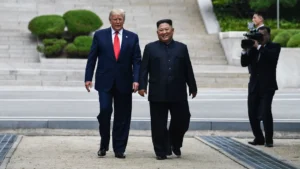
Figure 3 North Korean leader Kim Jong Un walks with President Trump north of the military demarcation line that divides North and South Korea, in the Joint Security Area of Panmunjom in the Demilitarized Zone, on Sunday. Photo: Brendan Smialowski/AFP/Getty Images
The case for re-electing Donald Trump, originally the consummate political outsider, has largely relied on his willingness to do what other presidential candidates will not. This is true for both domestic and foreign policy, with Trump’s outreach to North Korea in the 2018-19 period being especially noteworthy. After all, North Korea went from conducting regular medium-/long-range missile and nuclear tests up through the end of 2017 to their graduated cessation following Trump’s denunciations, vows to “completely destroy” North Korea should it threaten the US, and his willingness to resolve their disputes over dialogue. Whatever one thinks of Trump’s direct outreach to North Korean leader Kim Jong Un, such testing ostensibly halted by early 2018, before missile testing slowly resumed after the failed 2019 Hanoi summit and then picked up pace under Joe Biden, a president North Korea has largely regarded as not worth addressing.
Or so the story goes. In reality, North Korea, having demonstrated the increased potency of its nuclear arms and the ability to reach any part of the continental US via its long-range missiles—and seeing potentially pliant administrations in both Washington and Seoul—probably broke its diplomatic isolation in 2018 for reasons all its own. The failure of the 2019 Hanoi summit seemingly indicates that Trump’s vision of himself as a tough negotiator did not proceed him, and that Kim was furious that he did not receive a favorable deal.
This matters in assessing events from the last half of 2024 because—with the Biden interlude giving way to Trump 2.0—hopes of a return to the summitry of Singapore and Hanoi (with a hopefully better outcome) are already circulating, at least among those inclined to support diplomacy with Pyongyang. For others, this provokes worry—the Washington “blob” is nervous about the prospect, while the international press has already reported on South Korea’s concerns that Trump may seek to bypass them. Indeed reports have floated that some on the Trump team may indeed favor something of that nature. It is unclear how this would play out if South Korea were to soon have a left-leaning president rather than Yoon, who is skeptical of engagement with North Korea.
But the North Korea of 2018 is not the North Korea of 2024 or 2025. Its nuclear and missile programs have grown considerably (with significant ballistic missile (and rocket) testing and demonstration taking place during this reporting period), including a new Hwasong-19 ICBM seemingly successfully launched in November. Pyongyang now refers to South Korea as a hostile state, rather than a misguided brother state to be led toward unification (an attitude backed up by a hybrid war campaign of trash-filled balloons floated over South Korea). To be sure, Pyongyang’s harsh messaging toward Washington and Seoul has been consistent (even rising), but its diplomatic priorities have shifted. As noted in this issue’s China-Korea chapter, Pyongyang’s direct outreach to Beijing atrophied in the latter half of this year, and the Kim regime thus far has not deigned to respond to Trump’s electoral victory—a statement not long after the election result in which Kim called for “limitless” nuclear expansion to counter the US is the closest he has come to acknowledging the return of his old pen pal.
Both elements of this diplomatic shift likely have a common root. North Korea has found a kindred spirit in Vladimir Putin’s Russia, also regarded as an international pariah and revisionist power, and the two have developed a mutually beneficial arrangement that in the short-term goes beyond what they can get from China, much less the US. In the first reporting period of 2024, North Korea was already engaged in large-scale arms sales (notably artillery shells and missiles/rockets) to Russia in exchange for fuel, funding, modern (by North Korean standards) fighter jets, and missile defense support. This list reflects what is more or less publicly known, but informed speculation has broached the possibility of additional in-kind military assistance, including military satellite and re-entry vehicle technology, help with submarine design, and support in building out North Korea’s defense industrial base.
The June-December reporting period saw this relation deepen further. First, North Korea dispatched at least 10,000 troops to Russia to support Putin’s war against Ukraine. The current status of those troops—their training level and combat readiness, deployment areas, warfighting role, tactical and strategic value, etc.—is unknown, but the assumption is that they are likely engaged in the Kursk region of Russia in the counter-offensive to push back Ukraine’s incursion. Second, North Korea and Russia have strengthened their partnership diplomatically, signing a bona fide treaty alliance in June (during a Putin-Kim summit in North Korea), which came into force on December 4. Whether this alliance is sustainable—or rather an artifact of the Russia-Ukraine war, both states’ sanctions challenges, and perceived shared threats—remains to be seen, as dictators are not historically adept at long-term cooperation. For the moment, however, the Moscow-Pyongyang alliance helps both states alleviate their isolation. The US and South Korea have expressed deep concern about the advancement of North Korea-Russia relations, as it links together the Euro-Atlantic and East Asian theaters in ways that threaten both the US and South Korea individually and as alliance partners.
As mentioned above, Trump’s return to office likely means a different level and time horizon of US support for Ukraine, with the goal being to force an end to the war sooner rather than later (Ukraine may have to accept a settlement allowing Moscow to retain some of the territory the Russian army has seized). The knock-on effect may be that the Moscow-Pyongyang arms transfer ecosystem could dry up, which would be a positive for the US-South Korea alliance, insofar as that would presumably result in North Korea advancing more slowly on selected military programs. How one views this from Pyongyang would be a matter of perspective. On the one hand, there might be disappointment that the arrangement would become less beneficial; on the other hand, one could say that Kim rolled the dice on support for Putin and won.
Yoon Suk Yeol’s botched martial law declaration was not the only “December surprise” relevant to the Korean Peninsula and its diplomatic outlook. North Korea actually took an (unsurprisingly) cautious approach to the South Korean crisis, before eventually using it for domestic propaganda. But developments in the Middle East surely caught Pyongyang’s eye as well. Namely, the North’s sometime partner and fellow Russian client state, Bashar al-Assad’s Syria, fell to rebel forces on December 7, nearly 14 years after the Syrian Civil War began. Assad had over time regained control of his state, and stamped out resistance with Russian help, and that had persisted… until suddenly it didn’t.
A swift new rebel offensive swept through Aleppo and Homs before continuing into the Syrian capital and sending Assad fleeing to Moscow. In addition to Israel’s role in decimating Hezbollah and punishing Iran, the speed of the change demonstrated the extent to which Assad had relied on Russian support, which had dried up due to Russian forces being tied down in Ukraine’s eastern front. Russia’s reputation as a revisionist power able to halt the progress of the international order (and in some cases roll it back) while supporting dictatorial partners, has taken a major hit. Pyongyang was doubtless watching with some concerned interest.
Given that, rumors of Kim’s dissatisfaction as to how his troops have been employed in Ukraine, and Russia’s heavy losses during its recent offensive, one may conclude that the emerging Russia-North Korea axis might not be built for the long term. Pyongyang has historically profited from Beijing’s and Moscow’s willingness to compete for its attention, and, given the failure of its outreach to the US—another potential counterweight to China—in 2019, Kim appears to have reverted to the old habit of asking Russia to provide what China will not. If Moscow does not reverse its current losing streak, Pyongyang may be back on the market for new partners, even if the “new” partner is the same one that left Kim Jong Un at the altar in Hanoi.
In short: Comparative Connections has gone the length of the entire Biden administration with no meaningful diplomatic interactions between North Korea and the US to report. The Trump redux offers some possibilities of renewed outreach, but readers are urged to temper their expectations. Should it take place it will largely depend on the wishes of Kim, rather than Trump, and thus on how Kim assesses the options available to him.
Conclusion: Into the Unknown

Figure 4 U.S. President Joe Biden, Japan’s Prime Minister Fumio Kishida, and South Korea’s President Yoon Suk Yeol on the day of trilateral engagement during the G7 Summit in Hiroshima, Japan, on May 21, 2023. Photo: Jonathan Ernst/Reuters
This issue closes the book on Comparative Connections as an outlet for detailed triannual updates on bilateral relations in the Indo-Pacific. Few bilaterals have been harder to document than that of the US and North Korea, the “rogue state” par excellence that prides itself on its willingness to withstand pressure from the world’s strongest military power for decades. There has, on the other hand, been much to document in the relations between the US and South Korea, one of Washington’s oldest alliances in Asia, but one beset by fluctuations, such as progressive parties skeptical of long-term reliance on the US and conservative parties that, while usually reliable US partners, retain disconcerting ties to the country’s period of military rule that they have, based on recent events, not put completely behind them.
Pacific Forum has treated Comparative Connections as an extension of its overall mission, which is to foster dialogue between the US and the major players in Indo-Pacific diplomacy, including both the governments and publics in countries considered friendly, hostile, or ambivalent toward US interests. Doing so has required rigorous attention to detail, as captured in our meticulous attention to bilateral events, but also a commitment to honesty when it comes to US interests and values, some of which have left the US at odds with even long-term partners.
In that spirit: Much of the US foreign policy community welcomed the election of Yoon Suk Yeol in 2022, given his commitment to alignment with the US on regional security issues, openness to engagement with Japan, and well-deserved skepticism toward China. This welcome came despite the very clear flaws in Yoon as a candidate and statesman, manifest in his consistently low approval ratings, pushed down by his swirling scandals and gaffes. Now that Yoon has seemingly reached back to the spirit of Yushin to overthrow South Korea’s constitutional order—and revealed the deep contempt the military and even his own party have for him—it appears the effort spent on him by the Biden and Kishida administrations to deepen trilateral cooperation will not produce the expected benefits. Donald Trump’s return to office, along with a likely progressive successor to Yoon, will probably push Seoul toward greater autonomy in diplomatic and military affairs. The responsibility of the US foreign policy community may now shift to making this transition a smooth one—and preventing the outright collapse of Seoul-Tokyo ties. Those distraught by the return of the Democratic Party to power in Seoul can take comfort in that it is only popular relative to Yoon’s party, and even that may be short-lived.
North Korea will remain a thorny diplomatic issue regardless of how relations with Russia evolve, and whether Pyongyang reaches out to the Trump administration (much less reaches a deal). Even if Trump and Kim forge an understanding that lowers tensions for a time, North Korea has a decades-long history of hostility toward the US, Japan, and conservative elements in South Korea that will die hard. Trump, and all others who attempt to work with Pyongyang, should be prepared for tensions over the long term.
Administrations change, as will the format of Comparative Connections, but Pacific Forum’s mission will not.
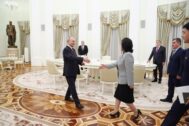
US - Korea
January — April 2024Right Where We Left It
The first reporting period of 2024 US-Korea relations was busy, both with managing ongoing issues (good and bad) and adapting to genuinely new evolutionary turns in US-Korea affairs. Concerning the former, US-South Korea relations continued on the same trajectory since President Yoon Suk Yeol assumed office in 2022: deepening bilateral alliance interoperability, enriching trilateral cooperation with Japan, increasing economic security policy convergence with the US. And this despite new foreign, defense, finance, and trade ministers in Seoul. Widely viewed as a referendum on Yoon, April National Assembly elections cast a shadow over much of his foreign and security policy during the reporting period. However, the crushing defeat of Yoon’s conservative People Power Party is unlikely to affect his approach to external affairs, where the president retains significant unilateral power. The “management” bucket also contains more threatening scenarios that have been building for months, years, decades. At the top of the list in importance is North Korea’s build-out of its nuclear and missile program, which continued apace in the January-April 2024 period, also providing more evidence of the essential hopelessness of international sanctions.

US - Korea
September — December 2023Calm in the Storm
There are many metaphors about using propitious moments to prepare for an inclement future: make hay while the sun shines, the best time to fix the roof is on a clear day, strike while the iron is hot, etc. These all imply the drudgery of work: a farmer baling hay on a sunny day, a slater shingling high on a roof under a blue sky, a forger hammering inside a sweltering workshop on a breezy afternoon. In a third semester continuation of the rest of a tense, yet stable 2023, there is a sense in which both South Korea and North Korea have been following the lesson of these proverbs as they use relative calm on the Korean Peninsula to build out their respective, opposed security and defense capabilities. Another, similar proverb captures an additional element of this dynamic: if you spend your whole life waiting for the storm, you’ll never enjoy the sunshine. Despite the tension on the Korean Peninsula, leaders in both Seoul and Pyongyang appear confident, even buoyant about their security and defense buildups.
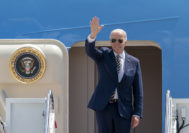
ROUNDTABLE
January 24, 2023Indo-Pacific Policy in the 2nd Half of Biden’s Term
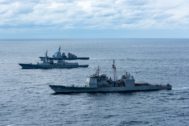
US - Korea
September — December 2022Everything Everywhere All at Once, Extremely Close and Incredibly Loud
Continuing a trend from the May-August reporting period, the final reporting period of 2022 in US-Korea relations was marked by an accelerated ratcheting up of tension. In short, numerous problems reared up on the Korean Peninsula from September-December, and good solutions have been few. And not only does this describe relations between the US and North Korea, but in their own, friendly way also the situation between Washington and Seoul, whose frequent invocations of rock-solid alliance cooperation belie unease about crucial areas of partnership.
Two critical issues have been increasingly affecting the US-South Korea alliance in 2022, with the September-December period no exception. First, South Korea desires ever more alliance-partner defense and security reassurance from the US in the face of a growing North Korean nuclear threat and Chinese revisionism. Yet the US has downward-trending limits on credible reassurance as North Korea masters nuclear weapons technology that threatens US extended nuclear deterrence for South Korea. The US also faces less geopolitical pressure to effusively reassure its Indo-Pacific allies—including South Korea—as China grows to menace the regional order and the US consequently faces lower risk of ally hedging or realignment.
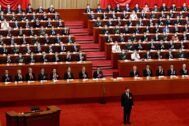
ROUNDTABLE
October 26, 2022China’s Foreign Relations After the Party Congress

US - Korea
May — August 2022Split Images
Lopsided: such was the state of US relations with the two Koreas during May-August 2022. The Washington-Seoul axis mostly flourished on the military/security, diplomatic, economic, and cultural fronts, while Washington and Pyongyang deepened doldrums whose depths had been plumbed in prior reporting periods. For the former, the most significant items included the May inauguration of conservative South Korean President Yoon Suk Yeol and quick follow-on summit with US President Joe Biden, increasing trilateral US-South Korea-Japan cooperation, a raft of announcements on US-South Korea economic and technology cooperation, the resumption of field maneuvers in US-South Korea joint military exercises, and South Korea’s continuing growth as a serious middle power player in foreign policy, including stepped-up engagement with NATO. In US-North Korea relations, a COVID-19 outbreak failed to lead the Kim Jung Un regime to open up to outside humanitarian assistance, as Pyongyang remained content to keep borders mostly closed and allow the virus to course through the population with only basic prophylactic measures. On the positive side, Pyongyang’s hyperactive missile testing in spring slowed during summer, and a feared (yet still expected) seventh nuclear test failed to materialize.
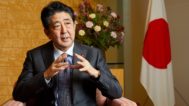

ROUNDTABLE
June 13, 2022Flashpoints in the Indo-Pacific Following the Russian invasion of Ukraine
